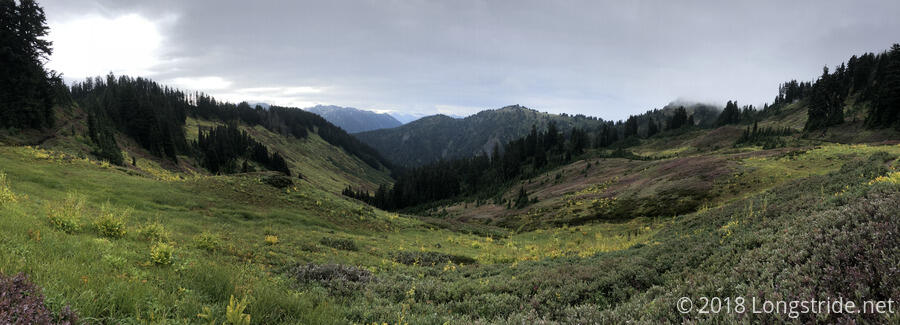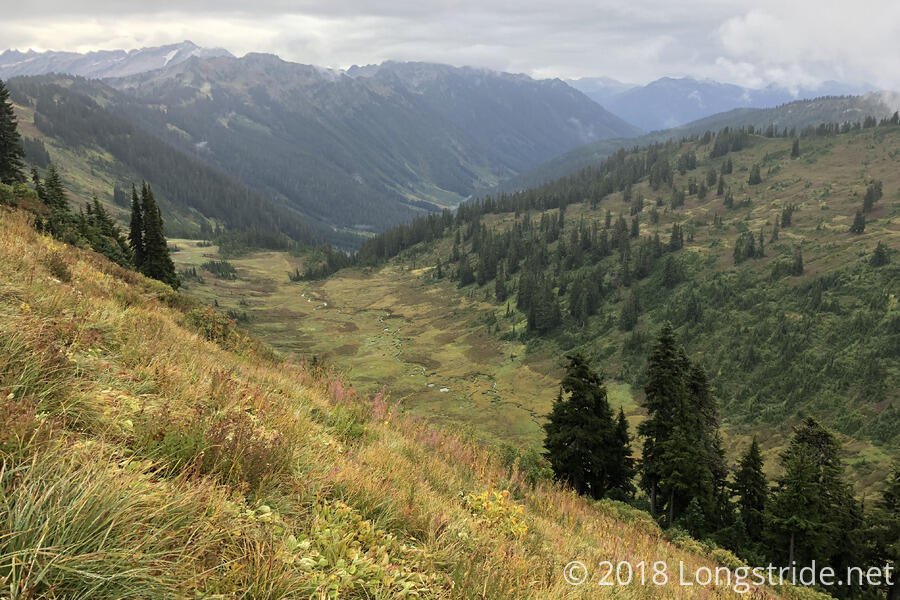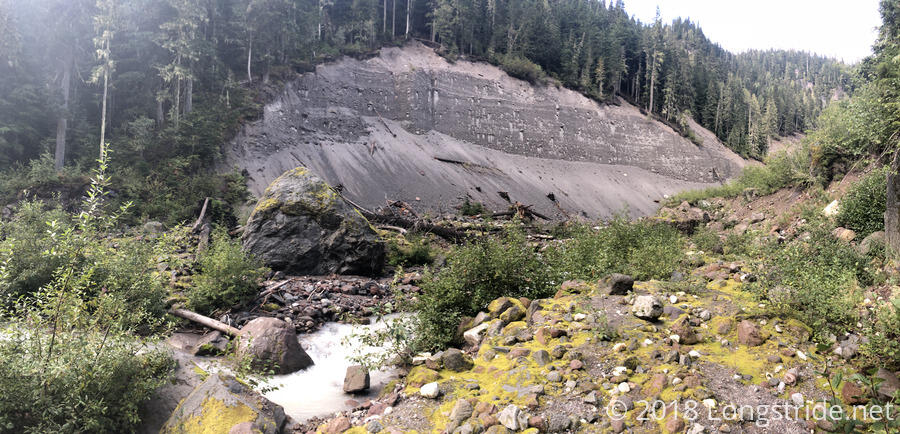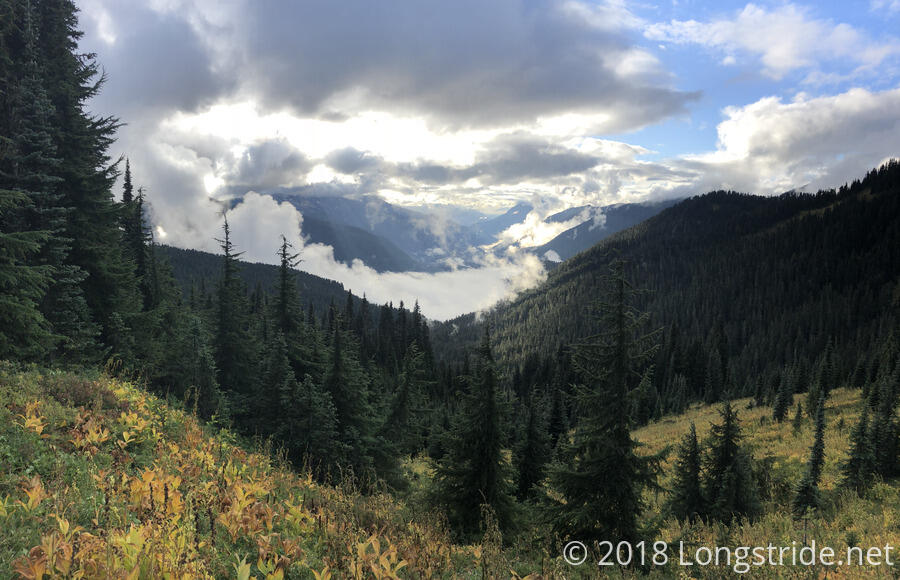After one of my most miserable nights on the trail, CareFree and I continued our trek through the northern Cascades, entering the Glacier Peak Wilderness, where we got rained and snowed on.
Unfortunately, in my haste to set the tent up last night, I pitched it with the top of the bathtub floor too low to the ground, and some water rolling off the top of the tent came in through the ventilation mesh, rather than falling to the ground. This again got our sleeping bags more wet, and with the cold, humid air outside, contributed to a very miserable night on the trail. Otherwise, CareFree’s rainfly draped over my tent to keep the water out was a success, and I think it might even have helped keep it a little warmer than it otherwise would have been.
With a 5 am alarm, we hoped we’d get hiking relatively early. However, 5 am is still a half-hour before sunrise, and with the dreary, foggy weather outside, not even marginally improved from last night, we were really in no hurry to get out of our nice warm tent.
In the Sierra, I had four pairs of socks, and I would rotate through three of them thanks to the stream crossings getting my feet wet. Now, I’m down to three pairs, and with yesterday’s pair still soaked, I switched to another pair today. With three more days until we get to Stehekin, though, if the rain continues as it has been, I’m going to run out of dry socks.
Once the sun rose, though, the clouds cleared, giving the impression that it would be a great day out. It was still cold, but the sun was out. That didn’t last, though. By the time we started hiking (around 8 am), the clouds had returned, and it wasn’t long after that before rain began to fall.
The trail continued roughly along a ridge, exposed to the rain. Trees were scarce; most of the ground was covered with short grasses, shrubs, and the occasional sapling. Possibly because of the recent rain, many of the grasses were a very vibrant green. Clouds blew along the valley, and the mountains ahead looked more rugged, with snow-covered peaks.
Around 9 am, a small, worn-down sign marked the entrance to the Glacier Peak Wilderness. Rain clouds obscured Glacier Peak itself. An hour later, with rain still falling, we passed the 2500 mile marker.
In need of a snack break, we tried to avoid the rain by beneath a small grove of trees. It helped, though the rain continued to drip off the leaves onto us. It wasn’t a terribly restful break; we didn’t sit down because everything was wet, but getting our packs off for twenty minutes was better than nothing.
The temperature continued to fall as we proceeded further into the Glacier Peak Wilderness, and the trail climbed substantially above 6,000 ft for the first time in a few hundred miles. With the clouds and rain, I wasn’t terribly surprised when snow started to fall. Unlike the snow that fell on me in the Sierra, this was a wet snow. The huge snowflakes (easily an inch wide, if not more) were quite pretty to look at while they fell through the sky, but being cold and wet, they were not so much fun to hike through.
The snowfall was heaviest while we were near the highest point of the day, and once we turned a corner, wrapping around the side of a mountain and beginning down a glacial valley, the snow gradually decreased. As we descended, the clouds lifted slightly, and we could see fresh snow accumulated near the mountaintops. We passed a few southbound hikers, including some wearing sandals!
The snow is the first reminder that it’s starting to become late in the season. The longer we’re in Washington, the more likely bad weather will find us, and the northern Cascades are notorious for big snowfalls without warning. I have to admit, after the difficult trail over the past week, the rain yesterday and this morning, and today’s cold and the snow, this afternoon was the closest I’ve ever been to wanting off the trail. Still, though, the best advice I’ve heard is to never quit on a bad day. And, we’re in the middle of nowhere, so all we can do now anyway is to keep going.
Re-entering the forest, not even an hour after noon, we passed by a surprising number of tents, both at established and improvised campsites. It was unclear if they were from people who stopped hiking because of the snow, or people who just didn’t start hiking today at all.
As we descended and it started to warm, the snow turned to rain, and the rain eventually stopped. Once in the forest, the trail paralleled a tributary of the White Chuck River, crossing it a couple of times, sometimes with a bridge, other times over a somewhat sketchy log crossing, before crossing the White Chuck River itself. Going down a relatively steep slope, both the tributary and the river had numerous waterfalls.
Near the bottom of the several mile descent down the valley, we reached a campsite at Baekos Creek, which flows from meltwater from one of the glaciers on Glacier Peak. We’d initially thought to stop and cook dinner there, but instead, we decided to only have a snack, and then push another nine miles to a creek with campsites. This turned out to be a good decision; we didn’t realize how much more difficult the rest of the day was going to become.
While we ate, CareFree hung her sleeping bag over the side of the bridge across the creek to attempt to dry it out. The sun came out once or twice, though not for any extended period, but at least being out in the open air helped it to dry a little.
After crossing the bridge over Baekos Creek. the trail continued through the forest, heading slightly downhill towards Kennedy Creek. That several miles of trail featured a lot of blowdowns and wet, marshy land, doing no favors to our not-very-dry shoes. The sun came out a few times, but did not stay out very long, retreating behind the clouds that insisted on darkening the sky.
Kennedy Creek, also flowing from a glacier on Glacier Peak, was in a deep river gorge. On the far side, a prominent nearly-vertical cliff shed debris to the valley floor. Trees at the top stood precariously, one landslide away from joining their fallen kin down by the river.
Fast-flowing, the creek had a bridge across, but at some point in the past, the bridge collapsed. Fortunately, that hasn’t hindered its usability. The middle of the bridge dips just below the water level, but someone placed a large rock there, presumably to stabilize the bridge and provide a stepping stone when the water level is higher.
After crossing the creek, we climbed steeply up to the ridge between Kennedy Creek and the next creek to the north, Glacier Creek. The ridge itself was fairly narrow, at times barely wider than the trail before steeply dropping off into the gorge on either side. After climbing high enough to cross the creek, the trail turned off the ridge, heading further uphill to cross over another ridge, eventually bringing us to Pumice Creek.
By this point, it was almost 6:30, and we were two miles short of Fire Creek, where we intended to camp. We considered pushing the rest of the way to Fire Creek, but that would get us to camp near or after sunset, which would mean it’d already be cold and dark by the time we set up our tent and got water for dinner. And, we were already pretty tired, the day having been a lot harder on us than we expected, so we stayed put, taking a less-than-ideal campsite near the edge of a cliff.
While I was setting up, the sun briefly came out, brightly illuminating the side of the ridge just long enough for me to get a picture, before setting behind the mountains to the west.
With the sun set, the temperature dropped quickly, though we were warm enough inside the tent, especially with a cup of tea and a hot meal to warm us up. A short snow flurry drifted through; I hoped it was just the humidity in the air freezing out, rather than a herald of poor overnight weather.
After my phone’s brief but worrisome stint refusing to charge, I suppose it wasn’t surprising that CareFree’s phone also developed problems: in addition to not charging, her phone somehow engaged a “safe mode” that refused to turn off, meaning that she could only use her phone’s built-in apps. I suspected it was likely due to water from the snow and rain earlier today getting in, and that once it dried out, it would go back to normal.





